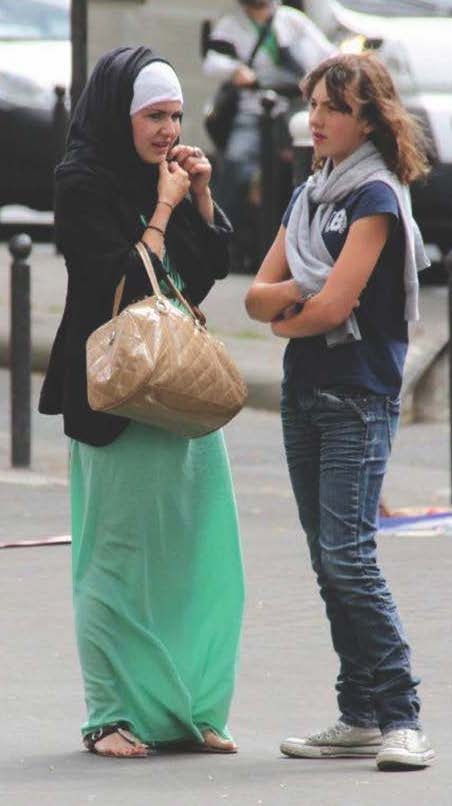Jeffrey G. Reitz,1 Patrick Simon,2 and Emily Laxer3
December 2022
Muslim immigrants’ religious affiliation and social integration in Western countries have been hot button issues particularly in the two decades of “war on terror” following 9/11, in response to attacks by persons claiming a global Islamic agenda in several countries and extensive media coverage keeping such issues in the spotlight. In this global conflict, Canada has been somewhat on the sidelines, and although the challenges of Muslim integration in Canada have received ample coverage, the difficulties they face in the community seem notably less pronounced than elsewhere. Is Canada really integrating Muslim immigrants more effectively than other countries?

Canada’s relative success in integrating large numbers of immigrants – so-called “Canadian exceptionalism” as reflected in high proportions of skilled immigrants and positive public attitudes toward immigration – has spawned an important debate. Does Canada’s success reflect only its judicious immigrant selection, or does it result instead from distinctive integration policies, such as multiculturalism, or other immigrant settlement policies? How, if at all, do these affect Muslims?
A recently-completed study of France and Canada, two immigration countries with quite different approaches to immigrant integration, offers an answer. France’s “republican model” emphasizes secularism and colour-blind exclusion of minority culture from the public sphere, whereas Canada’s “multicultural model” advocates official recognition of minority cultures. Supported by grants from Social Sciences and Humanities Research Council in Canada,4 and Research Executive Agency of the European Commission,5 we launched an extensive and comprehensive analysis of available survey data, census data, and in-depth field interviews. The research focuses attention on the everyday lives of Muslims and other minorities in the two countries, probing to identify any differences that may arise because of the respective national discourses, as opposed to other reasons.
Pervasive Barriers Across Settings
Most striking in our overall conclusions is that in both France and Canada, minorities of non-European origins experience substantial barriers to social, economic, and political integration, and Muslims in particular experience greater barriers in both countries. Of course, there are significant cross-national differences in their circumstances, but we found most resulted from the different demographic profiles of the minorities, including specific national origins and immigration histories, and the role of differing labour market and other national institutions. With only a few exceptions, barriers related to Muslim and other minority statuses were similar across settings. Full findings appear in a series of articles (2015-2022, listed below6), and are summarized herein.
Social integration
Two national surveys, Ethnic Diversity Survey in Canada (2002) and Trajectories and Origins Survey in France (2009), give useful data on experiences of discrimination, friendship networks, social trust, voluntarism, and national identity. Data show significant gaps for Muslims across settings, and often reflecting ethnic and cultural differences, more than religion specifically. Moreover, attachment to mainstream society grows over time and across generations in both countries, suggesting cultural assimilation.
A growing sense of inclusion may not always receive social validation. Muslims in France and Canada more often report discrimination than non-Muslim minorities and to about the same degree. In addition, second-generation Muslims both in France and Canada report discrimination much more often than first-generation immigrants. Race and visible minority status are more important sources of discrimination than religion, as the data show in three ways. First, all visible minorities report more discrimination, regardless of religion. Second, only one-third of Muslims themselves attribute discrimination to religion, mentioning race, skin colour, national origins, or accent. Third, the importance respondents attach to religion is unrelated to their reports of discrimination or other indicators of social integration.
Women and men report differing social issues across settings, but patterns of social integration are similar in the aggregate. For Muslim women in France and Canada, including English Canada as well as Quebec, negative attitudes toward the headscarf as a religious symbol cause significant social stigmatization and exclusion, including verbal harassment (our study was completed before the recent restrictive laws were adopted in Quebec). In France, legislated bans, while ostensibly intended to facilitate Muslim incorporation and generally supported by the public, often have the opposite effect. Our interviews probed the experiences of Muslim women wearing the headscarf in Paris, Montreal, and Toronto and found pervasive reports of mistreatment. In France, the mainstream legitimacy of bans means they are rarely challenged overtly, though they create resentment and distress. In Canada, where headscarf restrictions lack legitimacy and wearing a headscarf is more common, exclusion still occurs, creating resentment but also provoking more open resistance.
Psychological distress is a significant component of social integration and may reflect immigrants’ resilience. The 2001-2002 Canadian Community Health Survey and the 2008 French Enquête Santé sur la Protection Sociale ask questions relevant to constructing scales of psychological distress, for example, how often respondents feel “sad,” “nervous,” or “down in the dumps.” On average, Muslim minority-group members experience a higher level of psychological distress than other minorities in both Canada and France; the difference is not related to religious attachment but to unemployment and labour market inactivity. Again, the issue of minority religion so salient in media is a weaker factor “on the ground.”
For gender, the health surveys show higher levels of distress among Muslim women than men – about 10 percent – in both France and Canada. Interestingly, the Muslim gender difference in France follows the pattern in the mainstream population, whereas in Canada, higher levels of distress for women are more distinctive to Muslims. Overall, the impact of Muslim status is more negative on women than men in Canada; in France, the impact is similar for men and women.
Economic integration
We assessed the economic well-being of Muslim and other minorities in terms of overall household income (adjusted for household size), and employment earnings, based on the Trajectories and Origins Survey in France (2009) with the Canadian National Household Survey (2011). We found a striking cross-national difference in intergenerational economic trajectories for all immigrant minorities: flat in France, and upward in Canada, plausibly reflecting institutional differences. After adjusting for socio-demographic characteristics, religion and race matter in both settings, and net Muslim disadvantage in economic terms is similar. While religion appears somewhat more important in France, racial difference is more evident in Canada. But both matter. Focusing on labor market earnings discrimination, the Muslim gap is again similar in France and Canada.
Second-generation Muslim household incomes are somewhat higher in Canada than France, so we asked whether these might reflect the respective national models. Results suggested otherwise. In Canada, Muslim immigrant women have low labour force participation, but participation rates of women born in Canada are equal to mainstream populations. In France, Muslim women assimilate into the labour market, but less completely; second-generation women have lower rates of participation, reducing household incomes. The lower participation could be related to restrictive attitudes toward the headscarf, as Muslim women may simply avoid employment. However, analysis shows the effect of this difference on relative household incomes is small (about 1%) and offset by other income sources. Among second-generation Muslims in Canada, we find cohabitation with more affluent parents increases household incomes, suggesting immigrant selection has a cross-generational effect in providing economic resources and reinforcing the significance of immigrant selectivity, labor market structure, and welfare transfers.
Political integration
Fast-track citizenship for immigrants in Canada leads to higher rates of Muslim naturalization than in France, where rates are particularly low. Yet Muslim and other non-European origin minorities are less likely to vote in Canada. The “ethnic vote” is more often discussed in Canada but in both countries, members of minority groups vote in considerable numbers and thus have an impact on politics. We found little to support the expectation that higher rates of participation in civic associations and co-ethnic associations among immigrant minorities in Canada than France might be important in producing cross-setting differences in either citizenship or voting.
Previous research comparing France and Canada on the representation of immigrants in public office found representation higher in Canada at the federal level but lower at the regional and municipal level. Immigrants who are not citizens are eligible to vote in French municipal elections, and political parties have a role in selecting candidates for municipal office. These differences matter. During 2001-2012, Tunisian-born Bertrand Delanoë (not Muslim) was Mayor of Paris. He was more controversial for being gay than for being Tunisian. In the 2014 elections, he was replaced by Spanish-born Anne Hidalgo. In Canada, such elections in which minorities win a popular vote, when they occur, may be celebrated as victories for multiculturalism. In France, candidates’ backgrounds are largely ignored.
Implications: The Distraction of Diversity Discourse
In France and Canada, minorities of non-European origins experience substantial barriers to integration, and Muslims experience greater barriers in both countries. There are significant cross-national differences in their circumstances, but Muslim economic disadvantage in both countries mainly reflects immigrant selectivity and the resulting demographic profiles of immigrants and their descendants, as well as national labour market structures and social welfare regimes. Findings on social and political integration are similar.
Hence, Canada’s relative success in integrating immigrants, including Muslims, can be explained primarily by immigration policy and broader national institutions, not multiculturalism or welcoming public discourse. The difficulties in France result from immigration seen as the legacy of empire, not a nation-building project; moreover, labour markets and other institutions support immigrants’ immediate needs but do not facilitate their longer-term economic mobility. The small effects of “national models” revealed in other research is corroborated in our work on Muslims in France and Canada.
To be sure, differences in national models have important consequences, such as more rapid citizenship acquisition in Canada or more extensive legislated barriers to wearing the headscarf in France. More broadly, while exclusion based on religion is more prevalent in France, exclusion based on race is more salient in Canada. But the differences related to demography and national institutions matter far more than differences in national models or diversity discourse.
Further, the study uncovered some important aspects of the impact of differences in minority demography and in national institutions that had not previously been known, and which are well worth further study and analysis. For example, while the economic trajectories of immigrants with time in the country and across generational are more positive in Canada than in France, recent immigrants in Canada find the struggle to establish an economic foothold more difficult than do their counterparts in France, despite higher levels of education. The liberal labour market framework in Canada creates greater disadvantages for new immigrants, while social welfare supports in France smooth the experience of new settlers. At the same time, opportunities for minorities in the second generation seem less in France. Another finding worth pursuing is the apparent impact of inter-generational cohabitation on the second generation. This pattern is particularly relevant for second-generation Muslims, among whom the practice is quite common, but it also affects other immigrant groups. In France, the adult second generation less often lives with their parents, and when they do the economic impact is less positive because the immigrant parents have experienced less mobility.
Ultimately, our findings indicate that the significance of country-specific approaches to diversity as a factor in immigrant integration has been greatly exaggerated. As well, assumptions in such discourses about the salience of religion – versus, for instance, visible minority status – seem to be a matter of interpretation. Our findings suggest that race poses a more significant barrier to integration than Muslim religious affiliation, although the relative impact of each differs across contexts. The prevailing focus on both diversity discourse and religion also diverts attention from more critical dimensions of integration: getting a job, sending children to school, and playing a role in community decision-making, among others. The priority should be removing these barriers to integration, not – by elevating religion’s significance in public discourse – legitimating new ones.
1R.F. Harney Professor Emeritus, Munk School of Global Affairs and Public Policy, University of Toronto; and for this research was affiliated with l’École des Hautes Études en Sciences Sociales, Paris.
2Senior Researcher, Institut National Etudes Démographiques (INED) in Paris.
3Associate Professor, Glendon College, York University.
4SSHRC Insight Grant number 435-2012-0739 to J. Reitz
5Marie Curie Actions International Incoming Fellowship, European Commission Research Executive Agency, number PIIF-GA-2011-301049, awarded to J. Reitz
6Additional coauthors include Marie-Pier Joly and Jessica Stallone in studies comparing France and Canada, Alexandra Kassir in a study on France, and Rupa Banerjee, May B. Phan, and Jordan Thompson in studies of Canada.
Publications on the Integration of Muslims in Canada and France
2015. Jeffrey G. Reitz, “The Status of Muslim Minorities Following the Paris Attacks,” in After the Paris Attacks: Responses in Canada, Europe, and Around the Globe, Edward M. Iacobucci, Stephen J. Toope, eds. Toronto: University of Toronto Press. See also: “Integration of Muslim Minorities: Is it about religion?” Inroads: The Canadian Journal of Opinion 38(Winter-Spring, 2016):101-108; “The Status of Muslim Minorities during the War on Terror,” in Reading Sociology: Canadian Perspectives(3rd ed.), Lorne Tepperman, Patrizia Albanese, Emily Alexander, eds. Scarborough: Oxford University Press, 2017.
2016. Alexandra Kassir, Jeffrey G. Reitz, “Protesting Headscarf Ban: A Path to Becoming More French? A Case Study of ‘Mamans toutes égales’ and ‘Sorties scolaires avec nous,’” Ethnic and Racial Studies 39(15):2683-2700.
2017. Jeffrey G. Reitz, Patrick Simon, Emily Laxer, “Muslims’ Social Inclusion and Exclusion in France, Québec, and Canada: Does National Context Matter?” Journal of Ethnic and Migration Studies 43(15):2473–2498.
2017. Jeffrey G. Reitz, “Multicultural Nation-building and Canada’s Future: Implications of Comparative Research,” in Immigration and the Future of Canadian Society, Robert Brym, ed. Toronto: Rock’s Mills Press. (Based on the second S.D. Clark Symposium on the Future of Canadian Society, November 4, 2016.)
2018. Marie-Pier Joly, Jeffrey G. Reitz, “Emotional Stress and the Integration of Muslim Minorities in France and Canada,” International Migration Review 52(4):1111-1129.
2020a. Emily Laxer, Jeffrey G. Reitz, Patrick Simon, “Muslims’ Political and Civic Incorporation in France and Canada: Testing Models of Participation,” Journal of Ethnic and Migration Studies 46(17):3677-3702.
2020b. Emily Laxer, Jeffrey G. Reitz, Patrick Simon, “L’intégration civique des musulmans en France, au Québec et au Canada anglaise: quelle est l’incidence des ‘modèles’ nationaux?” (“Muslims’ Political and Civic Incorporation in France, Québec, and English-Canada: Do National ‘Models’ Play a Role?”), in Étudier le religieux au Québec: regards d’ici et d’ailleurs, David Koussens, Jean-François Laniel, Jean-Philippe Perreault, eds. Québec: Presses de l’Université Laval.
2022. Jeffrey G. Reitz, Emily Laxer, Patrick Simon, “National cultural frames and Muslims’ economic incorporation: a comparison of France and Canada,” International Migration Review 56(2):499-532.
2022. Emily Laxer, Jeffrey G. Reitz, Jessica Stallone, “Challenging the Legitimacy of Exclusion: Muslim Women and Social Boundaries in Different Headscarf Policy Contexts,” Ethnic and Racial Studies. Published online June 2022.
Additional Publications on the Integration of Muslims in Canada
2009. Jeffrey G. Reitz, Rupa Banerjee, Mai Phan, Jordan Thompson, “Race, Religion, and the Social Integration of New Immigrant Minorities in Canada,” International Migration Review 43(4):695-726.
2015. Jeffrey G. Reitz, Mai B. Phan, Rupa Banerjee, “Gender Equity in Canada’s Newly Growing Religious Minorities,” Ethnic and Racial Studies 38(5):681-699.




